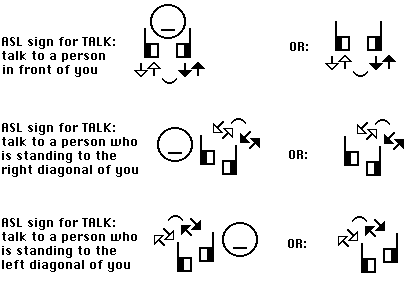|
QUESTION
0003:
How do you write the sign for "TALK" in ASL?
It is a directional verb. How do you show the directionality?
ANSWER
0003:
The arrows determine the direction of the sign. In this
case, the fingers are pointing up, but the direction fluctuates
depending on the arrows. Diagonal arrows show diagonal
"directionality".
|
EXAMPLES
0003:

|
| QUESTION
0005:
But how do you write a hand that is pointing up, but the
movement is not going up, it is going forward instead?
|
ANSWER 0005:
In the diagram below look at the first one to the left.
The hand is pointing forward. You know this because there
is a break at the finger joint. That little space or break
means pointing forward because the hand is parallel with
the floor.
The second handshape shows a hand that is parallel with
your chest. It is pointing up. So is the third handshape.
And the fourth hand is pointing forward, parallel with
the floor.
Then the movement symbols show the movement forward (single
stemmed) or up (double stemmed).

Reading the diagram above from left to right...
1. The first sign shows a hand pointing forward and moving
forward.
2. The second one shows a hand pointing up, but moving
forward.
3. The third shows a hand pointing up and also moving
up.
4. The fourth shows a hand that is pointing forward but
moving up.

In the above, the hand is pointing up, but the arrows
are moving forward or back. The hand, in other words,
is parallel with the wall, while the movement is parallel
with the floor. Two spatial planes intertwined. Don't
worry! You will learn this with practice! Children read
it quickly, so so can adults - ha! |





































































